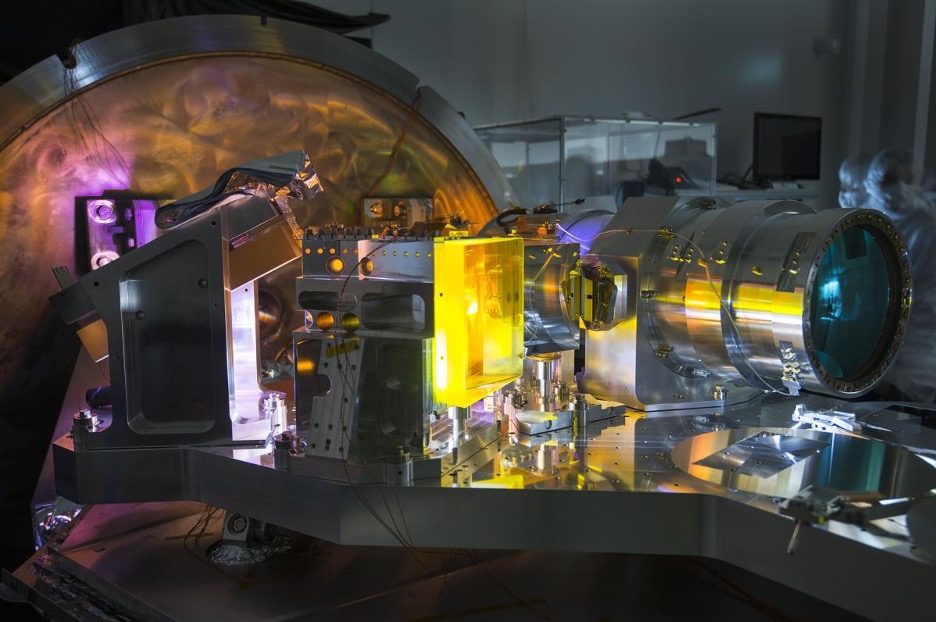- About▼
- Exo 101▼
- News
- Research▼
- Jobs + Internships▼
- Public Outreach▼
- Our Team▼
- Contact Us
- FR▼

It was on April 24, 2018, at about 7.50PM (Hawai’i Time), that the SPIRou (for SpectroPolarimeter Infrared) instrument collected light from a star for the first time. Installed on the Canada-France-Hawaii Telescope atop the Maunakea in Hawai’i, SPIRou is a high-resolution infrared spectropolarimeter and high-precision velocimeter. It is designed to detect Earth-like exoplanets through the motion induced on their host stars (the velocimetry method), as well as to study the magnetic fields of stellar systems.

The arrival of the SPIRou instrument atop Maunakea at the Canada-France-Hawaii Telescope on January 24, 2018. (Credit: Z. Challita/IRAP/WIPO)

An artist’s view of the very young erupting red dwarf AU Mic and its newly discovered planet, with the debris disk that gave rise to the planet in the distance. (Credit: NASA/JPL-Caltech)
The main objective of SPIRou is to detect rocky planets the size of the Earth in the habitable zone of low mass stars. SPIRou is optimised to observe in the near infrared (from 0.98 to 2.40 µm), covering the wavelength range where low mass stars are the brightest. The SPIRou data allow to measure the radial velocity of stars in order to detect tiny variations that hint at the presence of exoplanets. To successfully detect an Earth-like planet around a low-mass star, SPIRou must reach an accuracy of 1 m/s. This is the equivalent of the average walking speed of a human on Earth. In addition to measuring radial velocities, SPIRou is equipped with a spectropolarimeter that allows to differentiate the signature of planets from that of various signals caused by the presence of spots on the star.
Beyond detection, SPIRou plays an important role in the characterisation of exoplanets found by the transit method. Indeed, the discovery of an exoplanet detected by TESS, for example, gives us information on its radius and its orbital period. However, measurements with an instrument like SPIRou are necessary to establish its mass, estimate its density, and constrain its composition.
In addition to allowing the detection of a large number of planets in the solar neighbourhood, SPIRou can be used for several other projects, such as the detection of magnetic fields on forming stars, the study of the atmosphere of some transiting exoplanets, the spectral study of low mass stars, and the study of the cloud patterns on the surface of brown dwarfs.

A monochromatic infrared image obtained by SPIRou. The image has been colorised to represent in blue and red respectively the regions at different wavelengths from 1µm to 2.5µm (Credit: É. Artigau)
SPIRou is an instrument developed through an international collaboration including researchers from Quebec, Toulouse, Grenoble, Geneva, Taipei and Victoria.
The iREx and Observatoire du Mont-Mégantic team, with researchers based at the Université de Montréal and at the Centre d’optique, photonique et laser de l’Université Laval, has a strong expertise in infrared instrumentation. They were therefore well positioned to contribute to the design and construction of SPIRou.
The Université de Montréal team led the design and development of the SPIRou camera and infrared detector and contributed to a number of other components.
One of the two principal investigators of SPIRou is our Director, René Doyon. In addition, Étienne Artigau is one of the two project scientists of SPIRou. After having played an instrumental role in the design and construction of SPIRou, the iREx team is pleased to be able to use the instrument’s data for scientific research.
iREx researchers are using SPIRou data to study and better understand low-mass stars. SPIRou is also proving to be a very important tool for confirming and determining the mass of new exoplanets found by the TESS mission. Our researchers benefit from several hundred hours of observations each year, including through the SPIRou Legacy Surveys.
You must be logged in to post a comment.